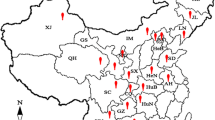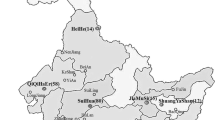Abstract
A total of 304Rhizoctonia solani isolates and 60 binucleateRhizoctonia-like fungi were recovered from stems and tubers of infected potato plants over a 2-yr period in northeast Turkey.R. solani isolates were identified to 11 anastomosis groups (AGs): AG-1 (0.66%), AG-2-1 (5.6%), AG-2-2 (0.99%), AG-3 (83.9%), AG-5 (4.6%), AG-6 (0.66%), AG-8 (1.32%), AG-9 (0.33%), AG-10 (1.32%), AG-12 (0.33%), and AG-13 (0.33%). In the greenhouse tests, most of the AG-3 isolates were significantly more virulent than isolates belonging to other AGs on potato cv. Batum. Isolates of other anastomosis groups differed in their virulence. Results indicated that AG-3 is an important pathogen on potatoes grown in the study area. Five of 22 commercial and local potato cultivars evaluated for their reaction toR. solani AG-3 isolates (TP-2) under greenhouse conditions were highly resistant; the remaining cultivars exhibited different levels of susceptibility to the pathogen isolate.
Similar content being viewed by others
References
Anderson, N. A. (1982) The genetics and pathology ofRhizoctonia solani.Annu. REv. Phytopathol. 20:329–347.
Anguiz, R. and Martin, C. (1989) Anastomosis groups, pathogenicity and other characteristics ofRhizoctonia solani isolated from potatoes in Peru.Plant Dis. 73:199–201.
Anon. (2001) European Cultivated Potato Database. http://194.128.220.6/web0/aweb/database.htm
Bandy, B.P., Leach, S.S. and Tavantzis, S.M. (1988) Anastomosis group 3 is the major cause of Rhizoctonia disease of potato in Maine.Plant Dis. 72:596–598.
Bandy, B.P., Zanziger, D.H. and Tavantzis, S.M. (1984) Isolation of anastomosis group 5 ofRhizoctonia solani potato field soils in Maine.Phytopathology 74:1220–1224.
Banville, G.J. (1989) Yield losses and damage to potato plants caused byRhizoctonia solani Kühn.Am. Potato J. 66:821–834.
Campion, C., Chatot, C., Perraton, B. and Andrivon, D. (2003) Anastomosis groups, pathogenicity and sensitivity to fungicides ofRhizoctonia solani isolates collected on potato crops in France.Eur. J. Plant Pathol. 109:983–992.
Carling, D.E. and Leiner, R.H. (1986) Isolation and characterization ofRhizoctonia solani and binucleateR. solani-like fungi from aerial stems and subterranean organs of potato plants.Phytopathology 76:725–729.
Carling, D.E. and Leiner, R.H. (1990) Virulence of isolates ofRhizoctonia solani AG-3 collected from potato plant organs and soil.Plant Dis. 74:901–903.
Carling, D.E., Leiner, R.H. and Kebler, K.M. (1987) Characterization of a new anastomosis group (AG-9) ofRhizoctonia solani.Phytopathology 77:1609–1612.
Carling, D.E., Leiner, R.H. and Westphale, P.C. (1989) Symptom signs and yield reduction associated with Rhizoctonia disease of potato induced by tuberborne inoculum ofRhizoctonia solani AG-3.Am. Potato J. 66:693–702.
Carling, D.E., Pope, E.J., Brainard, K.A. and Carter, D.A. (1999) Characterization of mycorrhizal isolates ofRhizoctonia solani from an orchid, including AG-12, a new anastomosis group.Phytopathology 89:942–946.
Chang, Y.C. and Tu, C.C. (1980) Pathogenicity of different anastomosis groups ofRhizoctonia solani Kühn. to potatoes.J. Agric. Res. China 29:1 (abstr.).
Demirci, E., and Doken, M.T. (1993) Anastomosis groups and pathogenicity ofRhizoctonia solani Kühn. isolates from potatoes in Erzurum-Turkey.J. Turk. Phytopathol. 22:95–102.
Hide, G.A., Read, P.J., Firmager, J.P. and Hall, S.M. (1989) Stem canker (Rhizoctonia solani) on five early and seven maincrop potato cultivars. II. Effects on growth and yield.Ann. Appl. Biol. 114:267–277.
Hill, C.B. and Anderson, N.A. (1989) An evaluation of potato disease caused by isolates ofRhizoctonia solani AG-3.Am. Patato J. 66:709–721.
Hodgson, W.A., Pond, D.D. and Munro, J. (1974) Diseases and Pests of Potatoes. Publ. Dept. of Agriculture, Canada. no. 1492, p. 64.
Mazzola, M., Wong, O.T. and Cook, R.J. (1996) Virulence ofRhizoctonia oryzae andRhizoctonia solani AG-8 on wheat and detection ofR. oryzae in plant tissue by PCR.Phytopathology 80:784–788.
Ogoshi, A. (1987) Ecology and pathogenicity of anastomosis and intraspecific groups ofRhizoctonia solani Kühn.Annu. Rev. Phytopathol. 25:125–143.
Ogoshi, A. (1996) Introduction — the genusRhizoctonia.in: Sneh, B., Jabaji-Hare, S., Neate, S. and Dijst, G. [Eds.]Rhizoctonia Species: Taxonomy, Molecular Biology, Ecology, Pathology, and Disease Control. Kluwer Academic Publishers, Dordrecht, the Netherlands. pp. 1–9.
Otrysko, B.E. and Banville, G.J. (1992) Effect of infection byRhizoctonia solani on the quality of tubers for processing.Am. Potato J. 69:645–652.
Parmeter, J.R. Jr., Sherwood, R.T. and Platt, W.D. (1969) Anastomosis grouping among isolates ofThanatephorus cucumeris.Phytopathology 59:1270–1278.
Rasochova, M. (1983) Current state and outlook of the potato variety collection from the standpoint of largescale production requirement.Rostl. Vyroba 23:165–175.
Read, P.J., Hide, G.A., Firmager, J.P. and Hall, S.M. (1989) Growth and yield of potatoes as affected by severity of stem cancer (Rhizoctonia solani).Potato Res. 32:9–15.
Scholten, O.E., Panella, L.W., De Bock, T.S.M. and Lange, W. (2001) A greenhouse test for screening sugar beet (Beta vulgaris) for resistance toRhizoctonia solani.Eur. J. Plant Pathol. 107:161–166.
Simons, S.A. and Gilligan, C.A. (1997) Relationships between stem canker, black scurf (Rhizoctonia solani) and yield of potato (Solanum tuberosum) under different agronomic conditions.Plant Pathol. 46:651–658.
Sneh, B., Burpee, L. and Ogoshi, A. (1991) Identification ofRhizoctonia Species. American Phytopathological Society, St. Paul, MN, USA.
Tuncer, G. and Erdiler, G. (1990) The identification ofRhizoctonia solani Kuhn. anastomosis groups isolated from potato and some other crops in Central Anatolia.J. Turk. Phytopathol. 19:89–93.
Yamamota, D.T. and Uchida, J.Y. (1982) Rapid nuclear staining ofRhizoctonia solani and related fungi with acridine and with safranin O.Mycologia 74:145–149.
Author information
Authors and Affiliations
Corresponding author
Additional information
http://www.phytoparasitica.org posting July 14, 2005.
Rights and permissions
About this article
Cite this article
Yanar, Y., Yılmaz, G., Cesmeli, I. et al. Characterization ofRhizoctonia solani isolates from potatoes in turkey and screening potato cultivars for resistance to AG-3 isolates. Phytoparasitica 33, 370–376 (2005). https://doi.org/10.1007/BF02981304
Received:
Accepted:
Issue Date:
DOI: https://doi.org/10.1007/BF02981304




